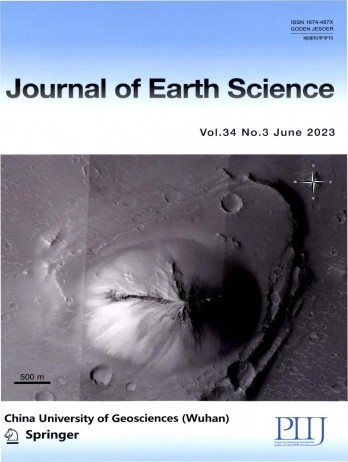
Journal of Earth Science雜志簡介
《Journal of Earth Science》創刊于1990年10月, 是由教育部主管、中國地質大學主辦的綜合性地學學術理論期刊。
《Journal of Earth Science》堅持黨的基本路線,提倡“雙百”方針,報道地學頂尖科研成果,交流地學創新學術思想, 實現“科教興國” 和科技期刊“可持續性發展”戰略。
《Journal of Earth Science》的辦刊宗旨是以反映中國地質大學教學與科研創新的、高水平的基礎地質、應用地質及資源與環境地質科研成果為主要任務,以促進國內外地學學術交流、繁榮我國地質教育、地質科技與地質找礦事業,為我國社會主義四化建設服務為目的。
《Journal of Earth Science》刊登內容主要包括:地層、古生物、巖石、礦物、構造、地球化學、應用地球物理、礦床地質、能源地質、找礦勘探、水文地質與工程地質、環境地質、災害地質、探礦工程、數學地質與遙感地質、應用地球物理, 信息工程等新理論、新技術、新方法及地學領域的邊緣、前沿學科的創新的、高水平的學術論文。
《Journal of Earth Science》自創刊以來, 得到眾多國內外地學及相關領域專家教授的高度贊譽。 特別是三本英文專輯在第三十屆國際地質大會上交流后,許多學者認為該學報英文版反映了中國地學研究的水平, 其內的許多論文達到國際先進水平。
目前, Journal of Earth Science與國際上100個國家地區的出版機構和學術團體建立了長期的訂購和贈閱交換關系。該刊曾榮獲“北京市科技期刊評比全優獎”, 被國際著名檢索系統《化學文摘》(CA)、日本《科學技術文獻速報》(CBST)、俄羅斯《文摘雜志》(PЖ)、《GeoRef》(美國地質科學光盤數據庫)等以及國內多種文摘期刊收錄。 為學校“211”工程建設與發展發揮了重要的作用。
Journal of Earth Science發文方向
地層、古生物、巖石、礦物、構造、地球化學、應用地球物理、礦床地質、能源地質、找礦勘探、水文地質與工程地質、環境地質、災害地質、探礦工程、數學地質與遙感地質、應用地球物理
Journal of Earth Science雜志特色
1.Manuscripts are to be written in English and double spaced. The original and two copies of the manuscripts together with the originals and two sets of copies of the figures should be submitted for review purpose. Papers are not to exceed 8 000 words nor to contain more than 7 figures and tables. Large figures and tables should be avoided, and their widths should generally be either 8.0, 16.5 or 24.0 cm. Each illustration should be clearly drawn and lettered.
2.The SI units of metric system should be used.
3.State secrets are not to be released. Authors take full responsibility for their papers.
4.We accept only unpublished, original papers and claim first right of publication. Papers unsuitable for our publication will be returned promptly.
5.Manuscripts should be organized in following order: (a) Title; (b) Name(s) and affiliation(s) of author(s); (c) Abstract (no more than 200 words) and key words (no more than 6); (d) Introduction; (e) Methods, techniques, studied material and area descriptions; (f) Results; (g) Discussion; (h) Conclusions; (i) Acknowledgments; (j) Explanation of plate; (k) References cited; (l) Tables; (m) Figure captions.
Headings
The following sequence should be used:
a.Free-standing capitals, bold, at the margin
b.Free-standing lower-case, bold, at the margin
If a further subdivision is needed, 1, 2, 3, etc., or (1), (2), (3), etc., or a, b, c, etc., should be used.
References Cited
All references cited to publications made in the text should be presented in a list of references following after the text. The manuscript should be carefully checked to ensure that the spelling of authors’ names and publication dates are exactly the
same in the text as in the reference list.
If reference is made in the text to publications written by more than two authors, the name of the first author should be given, followed by “et al.”. This indication, however, should never be used in the list of references. In this list, names of the first three co-authors followed by “et al.” should be given.
References in the text should be arranged chronologically. The list of references should be arranged alphabetically by authors’ names and chronologically per author.
The following system should be used for arranging references.
1.For periodicals
Chough, S. K., Barg, E., 1987. Tectonic History of Ulleung Basin Margin, East Sea (Sea of Japan). Geology, 15(1): 45–58
2.For books
Shrock, R. R., 1948. Sequence in Layered Rocks. McGraw-Hill, New York. 507
3.For multi-author books
Sun, S. S., 1984. Geochemical Characteristics of Archean Ultramafic and Mafic Volcanic Rocks: Implication and Evolution. In: Kroner, A., Lansor, G. N., Goodwin, A. M., eds., Archean Geochemistry. Springer-Verlag, Berlin. 25–46
4.For edited symposia, special issues, etc., published in a periodical
Fox, P. J., Ruddiman, W. F., Ryan, W. B. F., et al., 1971. The Geology of the Caribbean Crust, I. Beata Ridge. In: Heezen, B. C., Kosminskaya, I. P., eds., The Structure of the Crust and Mantle beneath Inland and Marginal Seas.
Tectonophysics, 10: 495–513
Periodical names should be given in full or abbreviated using the International List of Periodical Title Word Abbreviations. In addition, in referring to a personal communication the two words are followed by the year, e.g. “(MeNary, J., personal communication, 1968)”.
Footnotes
Footnotes should only be used if absolutely essential. If possible the information should be corporated in the normal text. If used, footnotes should be indicated by asterisks and kept as short as possible. If references are given in footnotes, full bibliographic data must be given in the list of references, not in the footnote.
All manuscripts should be governed by above information. Otherwise, publication of articles can be seriously delayed because of corrections.
雜志收錄與榮譽
Journal of Earth Science雜志數據統計注:由于版面限制,此處僅列出部分數據信息,了解詳情請聯系客服 了解詳情 >>
年度期刊評價報告 (本刊綜合數據對比及走勢)
名詞解釋:
影響因子:指該期刊近兩年文獻的平均被引用率,即該期刊前兩年論文在評價當年每篇論文被引用的平均次數
被引半衰期:衡量期刊老化速度快慢的一種指標,指某一期刊論文在某年被引用的全部次數中,較新的一半被引論文刊載的時間跨度
期刊他引率:他引率是指,此期刊被引用次數中,被其他刊引用次數所占的比例
引用半衰期:指某種期刊在某年中所引用的全部參考文獻中較新的一半是在最近多少年時段內刊載的
平均引文率:在給定的時間內,期刊篇均參考文獻量,用以測度期刊的平均引文水平,考察期刊吸收信息的能力以及科學交流程度的高低
雜志被引半衰期、引用半衰期
雜志影響因子、被引次數
雜志發文量、期刊他引率
雜志平均引文率
我們提供的服務
在線客服
一對一咨詢服務、簡單快捷、省時省力
了解更多 >快遞配送
直郵到家、實時跟蹤、更安全更省心
了解更多 >雜志訂閱
去除中間環節享受低價,物流進度實時通知
了解更多 >雜志推薦
正版雜志,匹配度高、性價比高、成功率高
了解更多 >期刊導航
常見問題
相關期刊
友情鏈接
免責聲明
若用戶需要出版服務,請聯系出版商,地址:湖北省武漢市洪山區魯磨路388號《地球科學》編輯部,郵編:430074。